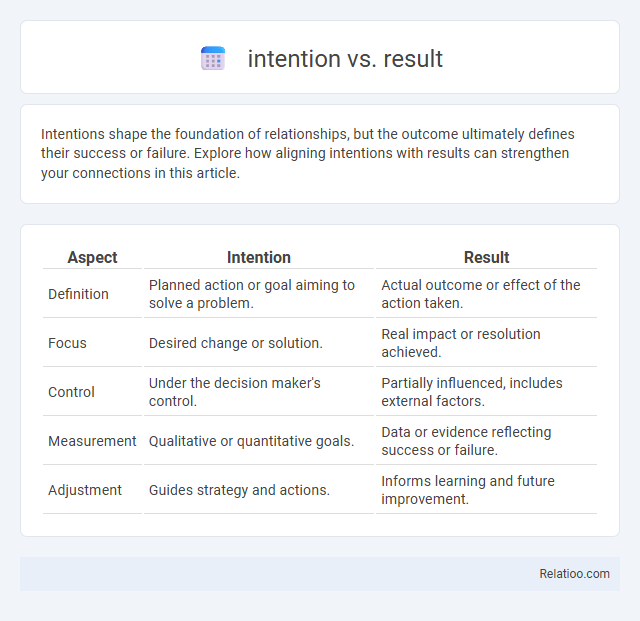Intentions shape the foundation of relationships, but the outcome ultimately defines their success or failure. Explore how aligning intentions with results can strengthen your connections in this article.
Table of Comparison
| Aspect | Intention | Result |
|---|---|---|
| Definition | Planned action or goal aiming to solve a problem. | Actual outcome or effect of the action taken. |
| Focus | Desired change or solution. | Real impact or resolution achieved. |
| Control | Under the decision maker's control. | Partially influenced, includes external factors. |
| Measurement | Qualitative or quantitative goals. | Data or evidence reflecting success or failure. |
| Adjustment | Guides strategy and actions. | Informs learning and future improvement. |
Understanding Intention: What Drives Our Actions
Understanding intention reveals the motivations behind actions, shaping the expected outcomes and guiding decision-making processes. Intentions are influenced by individual goals, beliefs, and contextual factors, which determine the alignment between desired and actual results. Unmet expectations emerge when outcomes diverge from intentions, highlighting gaps that prompt reflection and adjustment in future behavior.
The Nature of Results: Measuring Outcomes
The nature of results lies in measurable outcomes that reflect the actual impact of actions rather than intentions alone. Your focus should be on quantifying performance metrics and analyzing data to assess effectiveness and success accurately. Understanding unmet expectations requires comparing anticipated outcomes with these objective results to identify gaps and opportunities for improvement.
Intention vs Result: Why They Often Differ
Intention often differs from result because human actions are influenced by unpredictable variables and external factors beyond control, leading to outcomes that diverge from initial goals. Cognitive biases, incomplete information, and emotional responses can distort decision-making, causing a gap between what you intend and what actually occurs. Understanding this discrepancy helps manage unmet expectations by fostering realistic goal-setting and adaptive strategies in response to unforeseen challenges.
Psychological Factors Influencing Intentions
Psychological factors such as beliefs, attitudes, and motivation significantly shape intentions, which may not always align with actual results due to cognitive biases and emotional influences. Discrepancies between intentions and outcomes can lead to unmet expectations, often causing frustration or decreased self-efficacy. Understanding the interplay of intention formation and psychological barriers is crucial for improving goal attainment and managing expectations effectively.
External Variables Impacting Results
External variables such as market fluctuations, regulatory changes, and customer behavior shifts significantly impact the relationship between intention and result, often causing discrepancies between planned outcomes and actual achievements. These factors can create unmet expectations by altering the environment in which intentions are executed, leading to results that deviate from original goals. Understanding and anticipating external influences improves strategic adjustment, minimizing the gap between intention and result while addressing potential unmet expectations.
Common Misconceptions About Intentions and Outcomes
Common misconceptions about intentions and outcomes often confuse good intentions with guaranteed positive results, overlooking how external factors influence the actual impact. People tend to assume that a well-meaning action inherently leads to success, ignoring how unintended consequences or unmet expectations can arise despite positive intentions. Understanding the distinction between intention, result, and unmet expectation is crucial for realistic goal-setting and effective decision-making.
Real-Life Examples: When Intentions Clash with Results
When intentions clash with results, people often experience unmet expectations that lead to frustration and disappointment. For example, a company's intention to improve customer satisfaction through a new service policy may result in confusion and longer wait times, harming the customer experience. Similarly, a well-meaning parent's strict rules intended to instill discipline can sometimes cause rebellion and strained family relationships.
The Role of Accountability in Bridging the Gap
Accountability plays a critical role in bridging the gap between intention, result, and unmet expectations by ensuring responsible actions align with desired outcomes. Your commitment to transparent communication and ownership of outcomes fosters trust and enables timely adjustments to correct course when results fall short of intentions. Establishing clear metrics and feedback loops sharpens accountability, reducing misunderstandings and improving performance consistency.
Strategies to Align Intentions with Results
Strategies to align intentions with results focus on clear goal-setting, consistent progress tracking, and adaptive feedback mechanisms to ensure objectives are met effectively. Your ability to communicate expectations transparently and adjust strategies based on measurable outcomes reduces the risk of unmet expectations. Leveraging data-driven decision-making and reflective practices cultivates alignment between what is intended and what is ultimately achieved.
Lessons Learned: Embracing Both Intention and Outcome
Understanding the gap between intention and result is crucial for growth, as unmet expectations provide valuable lessons on aligning goals with actions. Embracing both your original intentions and the actual outcomes fosters resilience and adaptability, allowing you to refine strategies for future success. This perspective transforms setbacks into insights, enhancing decision-making and personal development.

Infographic: intention vs result
 relatioo.com
relatioo.com